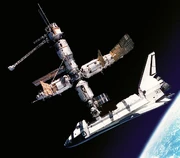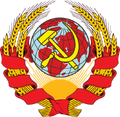
The 1988 launch of Buran.
The Buran program, officially the Energia-Buran program (Russian: Энергия-Буран, meaning "Energy-Blizzard"), is the manned launch vehicle program operated by the Soviet Union. The program began in 1974, initially as a response to the suspected military aspects of American Space Shuttle program. The program gained new light after the establishment of SAKA in 1992, when the new agency favored the program's aspects to bring back enthusiasm to the Soviet space program. The first manned mission took place in June 1994, and missions to the Mir and Mir 2 began in 1996. In February 2003, the Buran program would prove to be a life-saver after damage to the wing of Space Shuttle Columbia stranded the astronauts in space.
History[]
The idea of a reusable spacecraft for the Soviet space program gains its origins to the 1950s, with several attempts taking place. The Buran program, however, gains the majority of its roots from the Space Shuttle program of the United States. Soviet officials were concerned about the potential military adaptations of the American program. The 30-ton launch capability and 15-ton return capacity concerned many in Moscow that the US was using the program to test military hardware in space (such as the future Star Wars project). Due to Cold War hysteria, the future program would be built to have the same capacity (if not greater) as the Space Shuttle program. Ironically, this would lead to anger from NASA, who would later argue that the USSR copied the Space Shuttles (when it realty, this was not the case).
NPO Molniya would be contracted to develop the program (under the lead of Gleb Lozino-Lozinskiy). Construction would begin in 1980, with the first full-scale prototype rolling out in 1984. The first suborbital test flight of a scale-model took place in July 1983. As the project progressed, five additional scale-model flights were performed.
Construction on the first full spaceplane to be known as Buran began in 1986. The first flight took place on November 15, 1988 at 3:00 UTC. The spaceplane was lifted into orbit by the specially designed Energia booster rocket. The life support system was not installed and no software was installed on the CRT displays. The spaceplane orbited the Earth twice in 206 minutes of flight. On its return, it performed an automated landing on the specially constructed runway at Baikonur Cosmodrome in Kazakhstan. This would be the only flight of the Buran for years to come, as the economic and political situation in the Soviet Union forced the program to go into hiatus. With the establishment of the Union Aviation and Space Agency in 1992, the Buran program would gain new life. In 1993, the agency voted in favor to begin cancellation of the aging Soyuz program in favor of the Buran program, which would go back online later in the year.

Docking of Uragan to Mir in 1997.
The first unmanned flight of the second spaceplane Buria took place in late 1994. Construction of the three additional spaceplanes were completed in 1994 (Uragan) and 1995 (Taifun and Groza). The first manned flight took place on June 25, 1995, with cosmonauts Igor Volk and Aleksandr Ivanchenko piloting Uragan. The second manned flight took place on November 5, 1995, piloted by Anatoli Levchenko. Due to cost, the program was unable to perform launches on a regular basis (as the Space Shuttle). This would change in 1996 with the successful launch of the Energia II rocket, which was built as a fully reusable rocket (cutting cost down). The first mission to Mir took place on February 20, 1997, and construction on Mir 2 began in 1999.
In February 2003, the global importance of the Buran program would come to light as Uragan would assist in the evacuation of Columbia, which had suffered severe damage to the wing during launch on January 16, 2003.
List of shuttles[]
| Name (en) | Name (ru) | Meaning | Construction year | First flight |
|---|---|---|---|---|
| Buran | Буран | Blizzard | 1986 | November 15, 1988 |
| Burya | Буря | Tempest | 1988 | October 23, 1992 |
| Uragan | Ураган | Hurricane | 1990 | June 25, 1995 |
| Tayfun | Тайфун | Typhoon | 1991 | March 12, 1996 |
| Groza | Гроза | Thunderstorm | 1992 | July 7, 1996 |
| |||||||||||||||||

